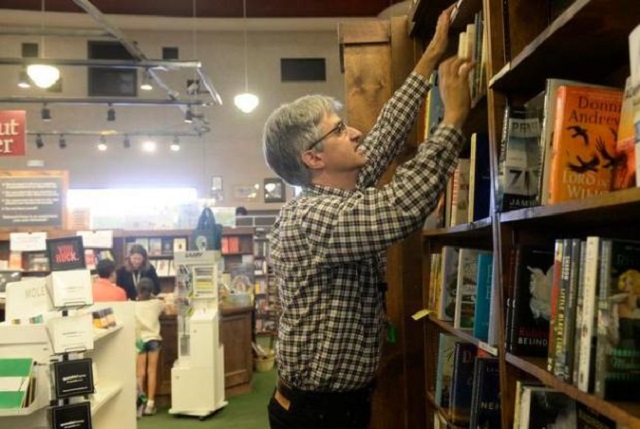PUBLISHED NOVEMBER 2017
by
Deb Vanasse, Reporter,
IBPA Independent magazine --

Deb Vanasse
Indie bookstores are thriving today. If indie publishers want to get their foot in the door, they need to understand the factors booksellers weigh when deciding which books to stock.
Forget the gloom-and-doom forecasts of a few years back. In the digital age, independent bookstores are thriving. Since 2010, upwards of 550 new bookstores have opened, and many booksellers are reporting an uptick in sales.
Yet as titles flood the market, shelf space remains at a premium. By understanding the factors that booksellers weigh when deciding what books to stock, publishers improve their odds in this healthy retail segment.
The Discovery Advantage
Booksellers are always eager to discover titles that will fly off the shelves, and these aren’t necessarily the same books that generate blockbuster sales online.
“Indie bookstores pride themselves on carrying unique products that you are not going to find just anywhere,” says Robert Sindelar, managing partner of Third Place Books (Seattle, Washington). “Discovering the cool local small press book of amazing poetry, awesome kids’ illustrated book, or locally sourced food cookbook is something we always have our eye out for.”

Third Place Books' Lake Forest Park location
Poisoned Pen Bookstore (Scottsdale, Arizona) owner Barbara Peters discovers new titles through e-newsletters from small presses such as Soho, Melville House, and Counterpoint. Reading the ARCs she requests—in print, not digital—is what’s most likely to convince her to stock a book. Swag and extra discounts rarely affect what she orders.

David Cheezem
Sales reps are also integral to the discovery process, says David Cheezem, owner of Fireside Books (Palmer, Arkansas). “The best ones really know us,” he explains. “They’ve seen what’s sold and what hasn’t. Sometimes, sales reps come out and say, ‘This book is more of an East Coast book. I’m not sure if you want to carry it.’ Those are the reps I listen to when they say I have to carry this new, unknown author.”
Publishers without sales reps can increase the odds of discovery by providing ample information about their titles, says Beach Books (Seaside, Oregon) owner Karen Emmerling. She suggests a well-produced mailing followed by a phone call or personal visit—provided the publisher acknowledges that a store owner’s attention must first go to customers.
Persistence is fine if it’s respectful, says Cheezem. “People come in every week with books,” he explains. “They pile up. I don’t often get to them on the first, or even the fifth follow-up phone call. I know I feel guilty about that. You can use that guilt to your advantage, but please be kind.”
Making the Match
In some ways, bookselling is a matchmaking endeavor. Not every book is a good fit for every store.
“We get approached by individual presses and authors about individual titles hundreds of times a month,” Sindelar says. “We simply can’t carry them all.” Is the book unique enough to stand out? Is the publisher’s marketing sufficient to send customers to the store? These are among the questions he poses to decide whether a proposed title is a good fit.
Cheezem stresses the importance of individual connections. “I like it best when I can picture one of my customers with your book,” he says. “I hold your book in my hand, and I think, ‘Oh, Helen is going to love this.’ Or maybe I think of one of our employees. If I think Kate or Ruth or Elias is going to get excited about your book, then I make sure they see it, because if they are excited, then they are going to share it with customers.”
Floor space is expensive, so booksellers must keep practical concerns front and center. But there is the occasional exception. “There are some books I hold onto for emotional attachment, prestige, the good of the community, what-have-you,” Cheezem says. “I will probably never sell that copy of Charles Olson's
The Maximus Poems in Palmer, Alaska. I’ll never return it either. I love that book, and I’ll stand by it. But that means some other poor book has to sell enough to subsidize my self-indulgent side.”
Tattered Cover Bookstore owner Len Vlahos (Denver, Colorado) limits consideration of independently published books to those released by Colorado authors in the previous three months. For consignment arrangements, he lists specific requirements—title and author on the spine, for instance, and ISBNs—on the Tattered Cover website.

Tattered Cover Bookstore's Len Vlahos checks the stacks for a customer's request
Similarly, Cheezem provides a form that asks who edited the book and what professional writing organizations the author has joined. “Blurbs help,” Cheezem says. “Editing helps. If you’re a member of a local literary organization, that attracts my attention.”
The Bottom Line
Even when a book seems a good match, logistical concerns may prevent it from making the cut.
“It is much easier for us to carry titles made available by the vendors with whom we routinely work,” Vlahos says. “We can send electronic orders, we get a reasonable discount, our books combine for discounts and often free shipping, shipping is relatively quick, and sometimes we’re offered favorable payment terms.”
Discounts are essential to a store’s bottom line. “I'm going to need at least a 40 percent discount and some decent shipping rates to carry your book,” Cheezem says. “I might bend a little for a special event if I really love your book, but I probably won’t be quick to reorder if it isn’t carrying its weight.”
Returns are an additional concern. “Books need to be ordered from and returned to an entity with which we deal regularly, where a credit will be useful,” Peters says. The problem of returns is among several reasons why, as a matter of policy, Poisoned Pen Bookstore doesn’t stock self-published or author services titles, nor do they stock titles without traditional distribution.
The On-Demand Factor
Print-on-demand (POD) titles may present additional concerns, though Sindelar notes that the
bias against POD is diminishing over time. “The quality of POD these days is pretty impressive,” he says. “It used to feel like an inferior product, but it doesn’t anymore, at least most of the time.”
If there are returnable terms and decent shipping rates, Cheezem doesn’t mind ordering POD. But he warns publishers to make sure they thoroughly understand how the terms come down on the bookselling end, especially if they’re working through an author services company.
“Sometimes your printer will short discount the distributor,” he says. “I’ve had writers tell me, ‘Oh, you can get my book from Ingram or Baker & Taylor for a regular discount.’ But when I looked, it wasn’t true.”
Emmerling points out that booksellers tend to look less favorably on POD titles from Createspace.

Karen Emmerling
“Remember, Amazon is a primary competitor,” she explains. “If an author wants his or her book in an independent bookstore, mentioning sales on Amazon is not a plus.”
To this end, savvy publishers make sure their websites include multiple options for purchase. “If your website is replete with only Amazon links, we’re going to take issue,” says Vlahos, noting that publishers can link to independent bookstores via
IndieBound.org.
Increasing the Odds
Vlahos points out that the process of placing titles in bookstores begins with ensuring that all elements of production—editing, cover design, layout, copy editing—are professional. “We want to present books to our customers that meet certain criteria, regardless of the publisher,” he says.
When approaching booksellers, Vlahos suggests publishers be prepared to discuss the audience for their titles as well as the efforts they’ll make to draw readers to the bookstore. “We stock over 100,000 titles,” he says. “What will set yours apart?”
To this end, Cheezem suggests finding comparable books shelved in the store and explaining how your book will reach the same audience. “‘This will be the next
Harry Potter,’ is not a compelling case,” he says.
He also urges publishers to provide a list of blogs and articles that have featured the book. “Even better, let us know about press interviews that are coming up, and promise to mention the store in those interviews,” he says.

Robert Sindelar
Sindelar advises publishers to take time to learn how bookstores work. Stores differ in market and emphasis, so research on individual stores also helps. “Every bookstore has its own personality, a profile molded in part by location and hugely by customer demand as well as a collection curated by its staff, who all read differently,” Peters says.
Not every store is a great fit for every title. “What we know better than anyone is what sells in our stores and what doesn’t,” Sindelar says. “Just because we don’t think your book is right for us doesn’t mean we don’t think your book can or will sell elsewhere.”
As with much else in the publishing business, bookstore placement involves building relationships. “They [publishers] go in, get to know the store, shop there, recommend the store to their friends, and make it easy for the store to carry their book,” Sindelar says. He points out that demonstrated sales success with one store creates an advantage when approaching other stores. For more tips on approaching bookstores,
click here.
Reaching Readers
Coveted as it is, bookstore placement is not the final goal. Neither publishers nor booksellers want titles to languish on shelves. “The same rule applies to indie published books as it does to traditionally published books,” Vlahos says. “We have to believe it’s a book we can sell and a book that will find an audience.”
In the end, it’s all about matching titles with booksellers who can readily move them into the hands of readers. By providing title information, attending to logistical concerns, and building relationships with booksellers, publishers increase the odds of reaching readers through bookstores.
Co-founder of 49 Writers and founder of the author co-op Running Fox Books, Deb Vanasse is the author of 17 books. Among her most recent are Write Your Best Book,
a practical guide to writing books that rise above the rest, and What Every Author Should Know,
a comprehensive guide to book publishing and promotion, as well as Wealth Woman: Kate Carmack and the Klondike Race for Gold.
Your Best Chances to Nab Shelf Space
- Get to know the bookstore’s inventory, and explain how your book will reach the same audience as certain books already shelved there.
- Toot your own horn. Provide a list of blogs and articles that have featured your book so the bookstore knows it’s hot.
- Let your bookstore of choice know about press interviews that are coming up, and promise to mention the store in those interviews.
- Build relationships and trust. Each bookstore is unique, so take the time to understand what makes Bookstore X popular.